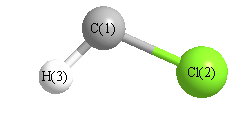Jump to
S2C1
Energy calculated at LSDA/cc-pVDZ
| | hartrees |
|---|
| Energy at 0K | -497.390167 |
| Energy at 298.15K | -497.390031 |
| HF Energy | -497.390167 |
| Nuclear repulsion energy | 38.571625 |
The energy at 298.15K was derived from the energy at 0K
and an integrated heat capacity that used the calculated vibrational frequencies.
Geometric Data calculated at LSDA/cc-pVDZ
Point Group is Cs
Cartesians (Å)
| Atom |
x (Å) |
y (Å) |
z (Å) |
|---|
| C1 |
0.047 |
1.197 |
0.000 |
| Cl2 |
0.047 |
-0.505 |
0.000 |
| H3 |
-1.072 |
1.406 |
0.000 |
Atom - Atom Distances (Å)
| |
C1 |
Cl2 |
H3 |
| C1 | | 1.7016 | 1.1383 |
Cl2 | 1.7016 | | 2.2146 | H3 | 1.1383 | 2.2146 | |
 More geometry information
More geometry information
Calculated Bond Angles
| atom1 |
atom2 |
atom3 |
angle |
|
atom1 |
atom2 |
atom3 |
angle |
| Cl2 |
C1 |
H3 |
100.607 |
|
Electronic energy levels
Charges, Dipole, Quadrupole and Polarizability
Charges from optimized geometry at LSDA/cc-pVDZ
Charges (e)
| Number |
Element |
Mulliken |
CHELPG |
AIM |
ESP |
| 1 |
C |
-0.199 |
|
|
|
| 2 |
Cl |
0.076 |
|
|
|
| 3 |
H |
0.123 |
|
|
|
Electric dipole moments
Electric dipole components in Debye
(What's a Debye? See section
VII.A.3)
| |
x |
y |
z |
Total |
| |
-1.460 |
-0.886 |
0.000 |
1.707 |
| CHELPG |
|
|
|
|
| AIM |
|
|
|
|
| ESP |
|
|
|
|
Electric Quadrupole moment
Quadrupole components in D Å
| Primitive |
|---|
| | x | y | z |
|---|
| x |
-19.338 |
-2.480 |
0.000 |
| y |
-2.480 |
-20.031 |
0.000 |
| z |
0.000 |
0.000 |
-17.852 |
|
| Traceless |
|---|
| | x | y | z |
|---|
| x |
-0.397 |
-2.480 |
0.000 |
| y |
-2.480 |
-1.436 |
0.000 |
| z |
0.000 |
0.000 |
1.832 |
|
| Polar |
|---|
| 3z2-r2 | 3.665 |
|---|
| x2-y2 | 0.693 |
|---|
| xy | -2.480 |
|---|
| xz | 0.000 |
|---|
| yz | 0.000 |
|---|
|
Polarizabilities
Components of the polarizability tensor.
Units are
Å
3 (Angstrom cubed)
Change units.
| |
x |
y |
z |
| x |
2.497 |
-0.365 |
0.000 |
| y |
-0.365 |
4.674 |
0.000 |
| z |
0.000 |
0.000 |
1.871 |
<r2> (average value of r
2) Å
2
| <r2> |
28.017 |
| (<r2>)1/2 |
5.293 |
Jump to
S1C1
Energy calculated at LSDA/cc-pVDZ
| | hartrees |
|---|
| Energy at 0K | -497.383016 |
| Energy at 298.15K | -497.382859 |
| HF Energy | -497.383016 |
| Nuclear repulsion energy | 39.076930 |
The energy at 298.15K was derived from the energy at 0K
and an integrated heat capacity that used the calculated vibrational frequencies.
Geometric Data calculated at LSDA/cc-pVDZ
Point Group is Cs
Cartesians (Å)
| Atom |
x (Å) |
y (Å) |
z (Å) |
|---|
| C1 |
0.037 |
1.147 |
0.000 |
| Cl2 |
0.037 |
-0.510 |
0.000 |
| H3 |
-0.856 |
1.799 |
0.000 |
Atom - Atom Distances (Å)
| |
C1 |
Cl2 |
H3 |
| C1 | | 1.6571 | 1.1061 |
Cl2 | 1.6571 | | 2.4761 | H3 | 1.1061 | 2.4761 | |
 More geometry information
More geometry information
Calculated Bond Angles
| atom1 |
atom2 |
atom3 |
angle |
|
atom1 |
atom2 |
atom3 |
angle |
| Cl2 |
C1 |
H3 |
126.143 |
|
Electronic energy levels
Charges, Dipole, Quadrupole and Polarizability
Charges from optimized geometry at LSDA/cc-pVDZ
Charges (e)
| Number |
Element |
Mulliken |
CHELPG |
AIM |
ESP |
| 1 |
C |
-0.200 |
|
|
|
| 2 |
Cl |
0.070 |
|
|
|
| 3 |
H |
0.130 |
|
|
|
Electric dipole moments
Electric dipole components in Debye
(What's a Debye? See section
VII.A.3)
| |
x |
y |
z |
Total |
| |
-0.832 |
-0.001 |
0.000 |
0.832 |
| CHELPG |
|
|
|
|
| AIM |
|
|
|
|
| ESP |
|
|
|
|
Electric Quadrupole moment
Quadrupole components in D Å
| Primitive |
|---|
| | x | y | z |
|---|
| x |
-18.228 |
-1.608 |
0.000 |
| y |
-1.608 |
-17.169 |
0.000 |
| z |
0.000 |
0.000 |
-19.427 |
|
| Traceless |
|---|
| | x | y | z |
|---|
| x |
0.070 |
-1.608 |
0.000 |
| y |
-1.608 |
1.658 |
0.000 |
| z |
0.000 |
0.000 |
-1.728 |
|
| Polar |
|---|
| 3z2-r2 | -3.455 |
|---|
| x2-y2 | -1.059 |
|---|
| xy | -1.608 |
|---|
| xz | 0.000 |
|---|
| yz | 0.000 |
|---|
|
Polarizabilities
Components of the polarizability tensor.
Units are
Å
3 (Angstrom cubed)
Change units.
| |
x |
y |
z |
| x |
1.991 |
-0.236 |
0.000 |
| y |
-0.236 |
4.532 |
0.000 |
| z |
0.000 |
0.000 |
1.576 |
<r2> (average value of r
2) Å
2
| <r2> |
27.733 |
| (<r2>)1/2 |
5.266 |
